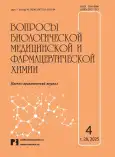Сравнительный анализ методов индукции стеатоза с использованием комплекса жирных кислот и бычьего сывороточного альбумина в модели in vitro на клетках HepG2
- Авторы: Князева Е.С.1, Виноходов Д.О.1
-
Учреждения:
- ФГБОУ ВО «Санкт-Петербургский государственный технологический институт (Технический университет)»
- Выпуск: Том 28, № 4 (2025)
- Страницы: 66-72
- Раздел: Биологическая химия
- URL: https://journal-vniispk.ru/1560-9596/article/view/290930
- DOI: https://doi.org/10.29296/25877313-2025-04-08
- ID: 290930
Цитировать
Аннотация
Введение. Неалкогольная жировая болезнь печени (НАЖБП) является одной из актуальных проблем здравоохранения, характеризующейся высоким ростом распространенности во всем мире. Это заболевание сопровождается избыточным накоплением липидов и развитием воспаления в печени. Для изучения механизмов патогенеза НАЖБП активно используется модель стеатоза с применением иммортализованных клеточных линий.
Цель работы – усовершенствование модели стеатоза in vitro с использованием клеток HepG2 путем сравнительного анализа двух методов индукции стеатоза с использованием комплекса жирных кислот (ЖК) с бычьим сывороточным альбумином (БСА), полученного методом простого растворения или конъюгирования.
Материал и методы. Жизнеспособность клеток оценивали с помощью XTT-теста. Накопление липидов в клетках HepG2 измеряли методом GPO-PAP, нормализуя уровни триглицеридов (ТГ) по содержанию клеточного белка. Продукцию провоспалительного цитокина ИЛ-8, как одного из маркеров воспаления, количественно определяли с помощью иммуноферментного анализа. Статистическую значимость оценивали с использованием t-критерия Стьюдента.
Результаты. Оптимальная концентрация ЖК, способствующая накоплению липидов и развитию воспаления без выраженного цитотоксического эффекта в клетках HepG2, составила 0,75 мМ. Конъюгированный комплекс ЖК-БСА привел к более высокому накоплению ТГ по сравнению с комплексом ЖК-БСА, полученным путем растворения. Однако уровни ИЛ-8 были значительно ниже в культуральной жидкости клеток HepG2, обработанных конъюгированным комплексом, по сравнению с клетками, обработанными комплексом ЖК-БСА, полученным путем растворения.
Выводы. Применение конъюгированного комплекса ЖК-БСА позволило усовершенствовать модель стеатоза in vitro, более приближенную к физиологическим механизмам развития НАЖБП.
Полный текст
Открыть статью на сайте журналаОб авторах
Е. С. Князева
ФГБОУ ВО «Санкт-Петербургский государственный технологический институт (Технический университет)»
Автор, ответственный за переписку.
Email: e.s.knyazeva@inbox.ru
ORCID iD: 0000-0002-4268-8881
SPIN-код: 1243-9665
преподаватель, кафедра молекулярной биотехнологии
Россия, 190013, г. Санкт-Петербург, Московский проспект, дом 24-26/49 литера АД. О. Виноходов
ФГБОУ ВО «Санкт-Петербургский государственный технологический институт (Технический университет)»
Email: vinokhodov@list.ru
ORCID iD: 0000-0001-7508-5457
SPIN-код: 7858-5950
д.б.н., доцент, зав. кафедрой молекулярной биотехнологии
Россия, 190013, г. Санкт-Петербург, Московский проспект, дом 24-26/49 литера АСписок литературы
- Riazi K., Azhari H., Charette J.H. et al. The prevalence and incidence of NAFLD worldwide: A systematic review and meta-analysis. Lancet Gastroenterol Hepatol. 2022; 7(9): 851–861. doi: 10.1016/S2468-1253(22)00165-0.
- Younossi Z.M., Golabi P., Paik J.M. et al. The global epi-demiology of nonalcoholic fatty liver disease (NAFLD) and nonalcoholic steatohepatitis (NASH): A systematic review. Hepatology. 2023; 77(4): 1335–1347. doi: 10.1097/HEP.0000000000000004.
- Teng M.L., Nguen A.K., Shah F.A. et al. Global incidence and prevalence of nonalcoholic fatty liver disease. Clin Mol Hepatol. 2023; 29(Suppl): S32–S42. doi: 10.3350/cmh.2022.0365.
- Soret P.A., Magusto J., Housset C. et al. In vitro and in vivo models of non-alcoholic fatty liver disease: A critical appraisal. J Clin Med. 2020; 10(1): 36. doi: 10.3390/jcm10010036.
- Ramos M.J., Bandiera L., Menolascina F. et al. In vitro models for non-alcoholic fatty liver disease: Emerging platforms and their applications. iScience. 2022; 25(1): 103549. doi: 10.1016/j.isci.2021.103549.
- Arzumanian V.A., Kiseleva O.I., Poverennaya E.V. The curious case of the HepG2 cell line: 40 years of expertise. Int J Mol Sci. 2021; 22(23): 13135. doi: 10.3390/ijms222313135.
- Pramfalk C., Larsson L., Härdfeldt J. et al. Culturing of HepG2 cells with human serum improves their functionality and suitability in studies of lipid metabolism. Biochim Biophys Acta Mol Cell Biol Lipids. 2016; 1861(1): 51–59. doi: 10.1016/j.bbalip.2015.10.008.
- Liang H., Huang Y., Zhang Y. et al. Inhibitory effect of gardenoside on free fatty acid-induced steatosis in HepG2 hepatocytes. Int J Mol Sci. 2015; 16(11): 27749–27756. doi: 10.3390/ijms161126058.
- Gómez-Lechón M.J., Donato M.T., Martínez-Romero A. et al. A human hepatocellular in vitro model to investigate steatosis. Chem Biol Interact. 2007; 165(2): 106–116. doi: 10.1016/j.cbi.2006.11.004.
- van der Vusse G.J. Albumin as fatty acid transporter. Drug Metab Pharmacokinet. 2009; 24(4): 300–307. doi: 10.2133/dmpk.24.300.
- Alsabeeh N., Chausse B., Kakimoto P.A. et al. Cell culture models of fatty acid overload: Problems and solutions. Biochim Biophys Acta Mol Cell Biol Lipids. 2018; 1863(2): 143–151. doi: 10.1016/j.bbalip.2017.11.006.
- Sergi D., Luscombe-Marsh N., Naumovski N. et al. Palmitic acid, but not lauric acid, induces metabolic inflammation, mitochondrial fragmentation, and a drop in mitochondrial membrane potential in human primary myotubes. Front Nutr. 2021; 8: 663838. doi: 10.3389/fnut.2021.663838.
- HepG2 Cell Culture. HepG2 Transfection. Accessed July 30, 2024. URL: https://hepg2.com/.
- Cell Proliferation Assay Kit XTT. AppliChem GmbH. Accessed August 20, 2024. URL: https://www.itwreage-nts.com/download_file/info_point/IP-029/en/IP-029_en.pdf.
- Randox Triglycerides (GPO-PAP). Randox Laboratories Ltd. Accessed August 20, 2024. URL: https://www.ran-dox.com/triglycerides-2/#1439389458347-fe65c57e-0e0b.
- Pierce™ BCA Protein Assay Kit. Thermo Fisher Scientific. Accessed August 20, 2024. URL: https://www.thermofi-sher. com/document-connect/document-con-nect.html? url=https:// assets.thermofisher.com/TFS-Assets/LSG/manuals/MAN00 11430_Pierce_BCA_Protein_Asy_UG.pdf.
- Интерлейкин-8 (ИЛ-8). ООО «Цитокин». Accessed July 30, 2024. URL: http://cytokine.ru/index.php?id=71.
- Щербакова Е.С., Салль Т.С., Ищенко А.М. и др. Иссле-дование процессов липогенеза и воспаления при неал-когольной жировой болезни печени на модели стеатоза с использованием клеток HepG2. Известия Санкт-Петер-бургского государственного технологического института (технического университета). 2019; 50(76): 92–96. [Shcherbakova ES., Sall TS., Ishchenko AM. et al. Study of lipogenesis and inflammation processes in nonalcoholic fatty liver disease on a steatosis model using HepG2 cells. Izvestiya Sankt-Peterburgskogo gosudarstvennogo tekhnologicheskogo instituta (tekhnicheskogo universiteta). 2019; 50(76): 92–96. (In Russ.)].
- Hosek J., Zavalova V., Kollar P. Effect of solvent on cytotoxicity and bioavailability of fatty acids. Immunopharmacol Immunotoxicol. 2010; 32(3): 462–465. doi: 10.3109/08923970903513147.
- Cupp D., Kampf J.P., Kleinfeld A.M. Fatty acid–albumin complexes and the determination of the transport of long chain free fatty acids across membranes. Biochemistry. 2004; 43(15): 4473–4481. doi: 10.1021/bi036335l.
Дополнительные файлы














